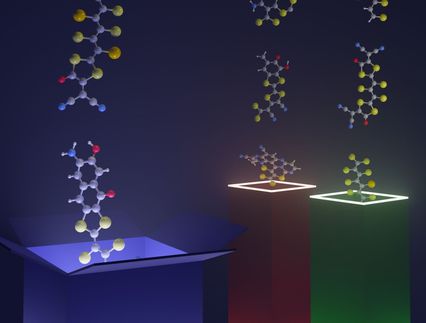Switching with molecules
Molecular switch will facilitate the development of pioneering electro-optical devices
A research team led by physicists at the Technical University of Munich (TUM) has developed molecular nanoswitches that can be toggled between two structurally different states using an applied voltage. They can serve as the basis for a pioneering class of devices that could replace silicon-based components with organic molecules.

Electrically switchable organic molecule.
Yuxiang Gong / TUM / Journal of the American Chemical Society
The development of new electronic technologies drives the incessant reduction of functional component sizes. In the context of an international collaborative effort, a team of physicists at the Technical University of Munich has succeeded to use single molecules as switching elements for light signals.
"Switching with just a single molecule brings future electronics one step closer to the ultimate limit of miniaturization," says nanoscientist Joachim Reichert from the Physics Department of the Technical University of Munich.
Different structure – different optical properties
The team initially developed a method that allowed them to create precise electrical contacts with molecules in strong optical fields and to address them using an applied voltage. At a potential difference of around one volt, the molecule changes its structure: It becomes flat, conductive and scatters light.
This optical behavior, which strongly depends on the structure of the molecule, is quite exciting for the researchers because the scattering activity – Raman scattering, in this case – can be both observed and, at the same time, switched on and off via an applied voltage.
Challenging technology
The researchers used molecules synthesized by a team based in Basel and Karlsruhe. The molecules change their structure in a specific way when they get charged. They are arranged on a metal surface and contacted using the corner of a glass fragment with a very thin metal coating as a tip.
This serves as an electrical contact, light source and light collector, all in one. The researchers used the fragment to direct laser light to the molecule and measure tiny spectroscopic signals that vary with the applied voltage.
Establishing reliable electric contacts between individual molecules is extremely challenging from a technical point of view. The scientists have now successfully combined this procedure with single-molecule spectroscopy, allowing them to observe even the smallest structural changes in molecules with great precision.
Competition for Silicon
One goal of molecular electronics is to develop novel devices that can replace traditional silicon-based components using integrated and directly addressable molecules.
Thanks to its tiny dimensions, this nanosystem is suitable for applications in optoelectronics, in which light needs to be switched by an electrical potential.
Original publication
Hai Bi, Carlos-Andres Palma, Yuxiang Gong, Peter Hasch, Mark Elbing, Marcel Mayor, Joachim Reichert und Johannes V. Barth; "Voltage-Driven Conformational Switching with Distinct Raman Signature in a Single-Molecule Junction"; J. Am. Chem. Soc.; 140, 14, 4835-4840
Original publication
Hai Bi, Carlos-Andres Palma, Yuxiang Gong, Peter Hasch, Mark Elbing, Marcel Mayor, Joachim Reichert und Johannes V. Barth; "Voltage-Driven Conformational Switching with Distinct Raman Signature in a Single-Molecule Junction"; J. Am. Chem. Soc.; 140, 14, 4835-4840
Topics
Organizations
Other news from the department science

Get the chemical industry in your inbox
By submitting this form you agree that LUMITOS AG will send you the newsletter(s) selected above by email. Your data will not be passed on to third parties. Your data will be stored and processed in accordance with our data protection regulations. LUMITOS may contact you by email for the purpose of advertising or market and opinion surveys. You can revoke your consent at any time without giving reasons to LUMITOS AG, Ernst-Augustin-Str. 2, 12489 Berlin, Germany or by e-mail at revoke@lumitos.com with effect for the future. In addition, each email contains a link to unsubscribe from the corresponding newsletter.
Most read news
More news from our other portals
Last viewed contents
Destination China as Level Sensors and Transmitters Markets Make a Comeback - Increased investments in manufacturing and greater automated production to fuel demand in emerging economies
HLA-DR51
InfoChem releases SPRESIweb version 2.0 - New version of Web-based research tool for one of the largest structure and reaction databases worldwide launched
Researchers develop ultra-simple method for creating nanoscale gold coatings
Wayne_L._Hubbell
Category:Vanadium_minerals
Hydroxocobalamin
Agilent Technologies Opens New X-ray Diffraction Manufacturing Facility in Wroclaw, Poland
Rheopecty
Dichlorocarbene
Edwin_B._Hart





























































